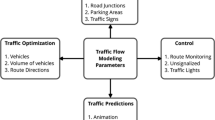Abstract
Traffic flow prediction is an important component for real-time traffic-adaptive signal control in urban arterial networks. By exploring available detector and signal controller information from neighboring intersections, a dynamic data-driven flow prediction model was developed. The model consists of two prediction components based on the signal states (red or green) for each movement at an upstream intersection. The characteristics of each signal state were carefully examined and the corresponding travel time from the upstream intersection to the approach in question at the downstream intersection was predicted. With an online turning proportion estimation method, along with the predicted travel times, the anticipated vehicle arrivals can be forecasted at the downstream intersection. The model performance was tested at a set of two signalized intersections located in the city of Gainesville, Florida, USA, using the CORSIM microscopic simulation package. Analysis results show that the model agrees well with empirical arrival data measured at 10 s intervals within an acceptable range of 10%–20%, and show a normal distribution. It is reasonably believed that the model has potential applicability for use in truly proactive real-time traffic adaptive signal control systems.
Similar content being viewed by others
References
ROBERTSON D I, BRETHERTON R D. Optimizing networks of traffic signals in real time-the SCOOT method [J]. IEEE Transaction on Vehicular Technology, 1991, 40(1): 11–15.
LOWRIE P R. SCATS: A traffic responsive method of controlling urban traffic control [R]. Roads and Traffic Authority, 1992.
HEAD K L. Event-based short-term traffic flow prediction model [J]. Transportation Research Record, 1995, 1510: 45–52.
MIRCHANDANI P M, WANG F Y. RHODES to intelligent transportation systems [J]. IEEE Intelligent Systems, 2005, 20(1): 10–15.
CAREY M, GE Ying-en, MCCARTNEY M. A whole-link travel-time model with desirable properties [J]. Transportation Science, 2003, 37(1): 89–96.
ZHENG Xing, RECKER W, CHU Lian-yu. Optimization of control parameters for adaptive traffic-actuated signal control [J]. Journal of Intelligent Transportation Systems, 2010, 14(2): 95–108.
MAHER M J. Estimating the turning flows at a junction: A comparison of three models [J]. Traffic Engineering and Control, 1984, 25: 19–22.
DAVIS G A, LAN C J. Estimating intersection turning movement proportions from less-than-complete sets of traffic counts [J]. Transportation Research Record, 1995, 1510: 53–59.
CHANG G L, TAO X. Estimation of time-dependent turning fractions at signalized intersections [J]. Transportation Research Record, 1997, 1644: 142–149.
NOBE S. On-line estimation of traffic split parameters based on lane counts [D]. The University of Arizona, 1997.
SUN Daniel(Jian), KONDYLI A. Modeling vehicle interactions during lane changes on arterial streets [J]. Computer-Aid Civil and Infrastructure Engineering, 2010, 25(8): 557–571.
SUN Daniel(Jian), ELEFTERIADOU L. Research and implementation of lane-changing model based on driver behavior [J]. Transportation Research Record, 2010, 2161: 1–10.
PORCHE I, LAFORTUNE S. Adaptive look-ahead optimization of traffic signals [J]. Journal of Intelligent Transportation Systems, 1999, 4(3/4): 209–254.
LIU Tian-liang, HUANG Hai-jun, TIAN Li-jun. Microscopic simulation of multi-lane traffic under dynamic tolling and information feedback [J]. Journal of Central South University: Science and Technology (English Edition), 2009, 16(5): 865–870.
MAKRIDAKIS S, WHEELWRIGHT S C, MCGEE V E. Forecasting: Methods and applications [M]. New York: John Wiley and Sons, 1998: 43–54.
Author information
Authors and Affiliations
Corresponding author
Additional information
Foundation item: Project(71101109) supported by the National Natural Science Foundation of China
Rights and permissions
About this article
Cite this article
Sun, J., Zhang, L. Vehicle actuation based short-term traffic flow prediction model for signalized intersections. J. Cent. South Univ. Technol. 19, 287–298 (2012). https://doi.org/10.1007/s11771-012-1003-8
Received:
Accepted:
Published:
Issue Date:
DOI: https://doi.org/10.1007/s11771-012-1003-8




